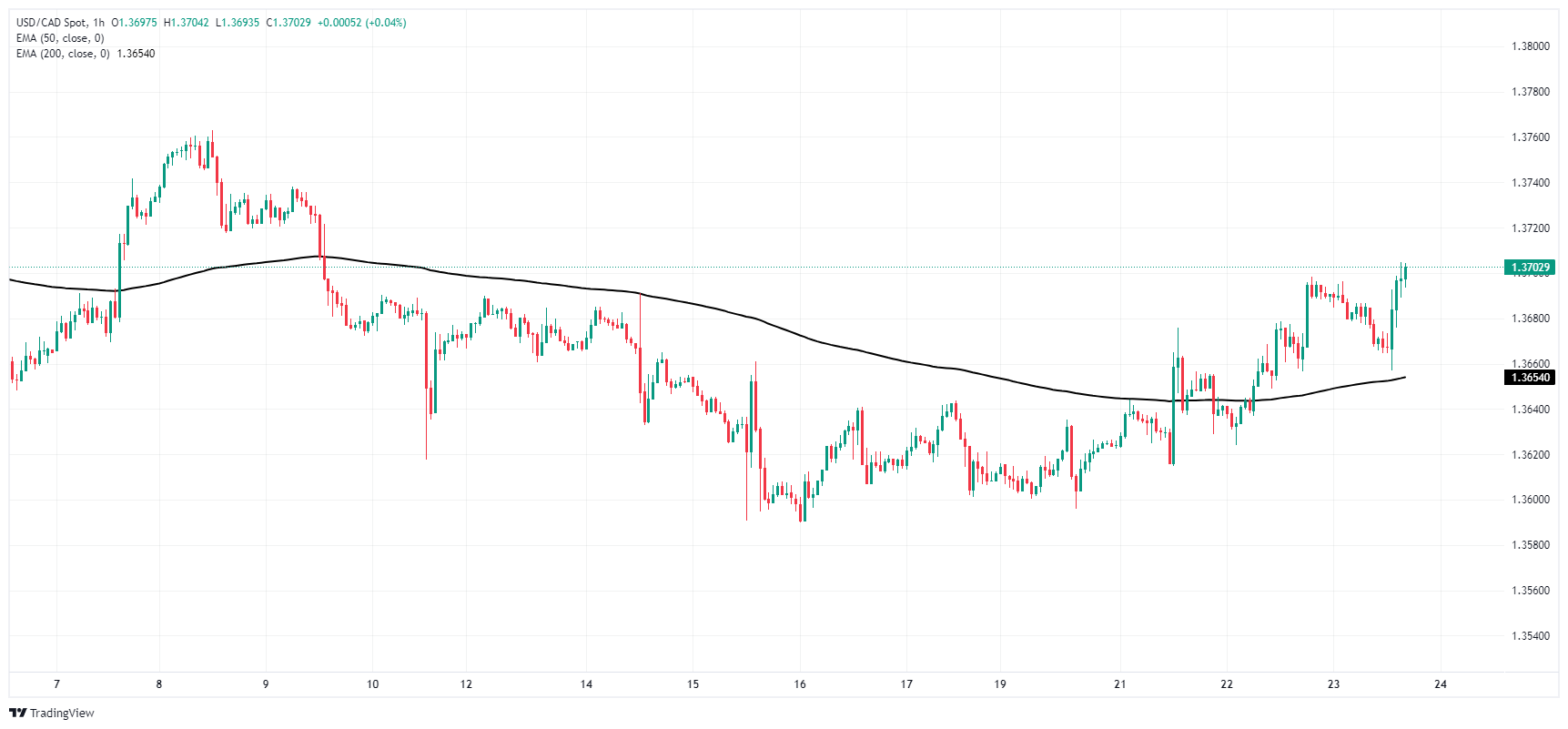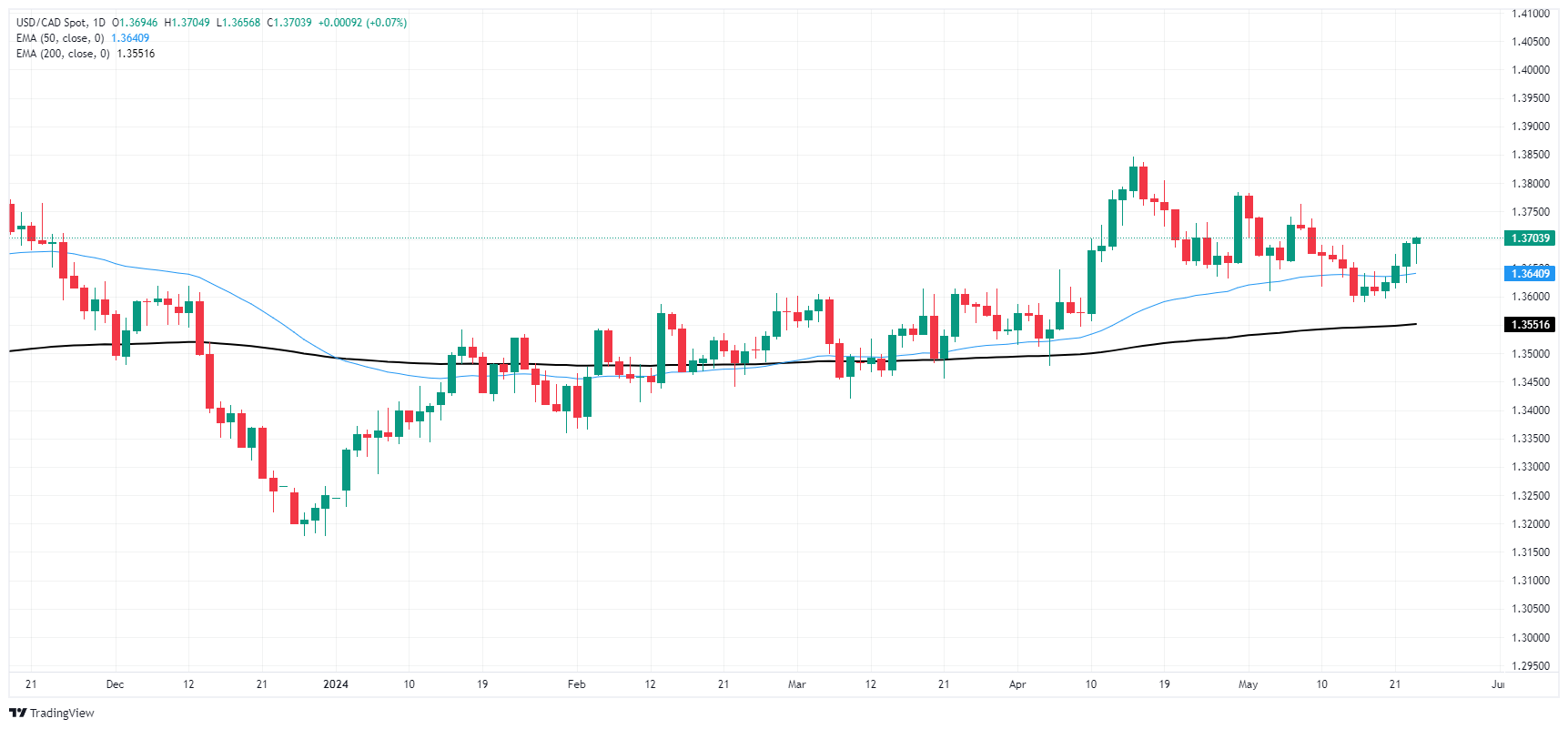- Phân tích
- Tin tức và các công cụ
- Tin tức thị trường
- Canadian Dollar softens further, adds to losses on Thursday
Canadian Dollar softens further, adds to losses on Thursday
- Canadian Dollar broadly weaker, loses ground across board.
- Canada brings little meaningful data to the table.
- CAD traders forced to wait until Friday’s Retail Sales.
The Canadian Dollar (CAD) backslid once again on Thursday, piling on further weakness and dipping to 30-week lows. A lack of meaningful Canadian economic data is giving the CAD little support, and markets are focusing on an upside surprise in US Purchasing Managers Index (PMI) figures in May.
Canada will print March Retail Sales on Friday, alongside US Durable Goods Orders. The latest update from the University of Michigan’s Consumer Sentiment Index will also be delivered on Friday. Investors are broadly expecting Canadian Retail Sales to rebound slightly, while US Durable Goods are expected to soften slightly. Meanwhile, UoM Consumer Sentiment is expected to tick upwards, while Consumer Inflation Expectations are forecast to hold steady at 3.1%.
Daily digest market movers: Canadian Housing sees little impact against US PMI figures
- Canadian New Housing Price Index rises 0.2% MoM in April versus the previous 0.0%. Investors expected a print of 0.1%.
- US Initial Jobless Claims eased to 215K in the week ended May 17, down from the previous week’s 223K (revised from 222K) and below the forecast of 220K.
- US S&P Global Manufacturing PMI recovered to 50.9 in May, climbing over the forecasted hold of 50.0.
- The Services PMI component also rose to a 12-month high of 54.8.
- Market hopes for a September rate cut from the Federal Reserve (Fed) are evaporating. According to the CME FedWatch Tool, rate markets are pricing in barely over 50% odds of a quarter-point cut in September, down sharply from over 70% odds at the beginning of the week.
Canadian Dollar PRICE Today
The table below shows the percentage change of Canadian Dollar (CAD) against listed major currencies today. Canadian Dollar was the weakest against the New Zealand Dollar.
| USD | EUR | GBP | JPY | CAD | AUD | NZD | CHF | |
|---|---|---|---|---|---|---|---|---|
| USD | 0.04% | 0.04% | 0.16% | 0.10% | -0.00% | -0.15% | -0.08% | |
| EUR | -0.04% | 0.00% | 0.14% | 0.06% | -0.04% | -0.19% | -0.13% | |
| GBP | -0.04% | -0.00% | 0.14% | 0.05% | -0.04% | -0.20% | -0.13% | |
| JPY | -0.16% | -0.14% | -0.14% | -0.07% | -0.18% | -0.38% | -0.26% | |
| CAD | -0.10% | -0.06% | -0.05% | 0.07% | -0.10% | -0.25% | -0.19% | |
| AUD | 0.00% | 0.04% | 0.04% | 0.18% | 0.10% | -0.15% | -0.10% | |
| NZD | 0.15% | 0.19% | 0.20% | 0.38% | 0.25% | 0.15% | 0.07% | |
| CHF | 0.08% | 0.13% | 0.13% | 0.26% | 0.19% | 0.10% | -0.07% |
The heat map shows percentage changes of major currencies against each other. The base currency is picked from the left column, while the quote currency is picked from the top row. For example, if you pick the Canadian Dollar from the left column and move along the horizontal line to the US Dollar, the percentage change displayed in the box will represent CAD (base)/USD (quote).
Technical analysis: Softer CAD eases further, sends USD/CAD higher to 1.3700
The Canadian Dollar (CAD) is broadly weaker on Thursday, shedding weight across the board. The CAD is down three-tenths of one percent against the New Zealand Dollar (NZD) and a fifth of one percent against the Australian Dollar (AUD).
USD/CAD rose to the 1.3700 handle on Thursday as the mixed-performance Greenback outpaces the softening Canadian Dollar. The pair has risen into a two-week high and is on pace to close higher for a fourth straight day. Four of the last five daily candles have closed in the green.
USD/CAD is extending a bullish rebound from the 1.3600 handle as the pair rises further from the 200-day Exponential Moving Average (EMA) at 1.3551. However, the pair still remains down from the last major swing high into 1.2850 in mid-April.
USD/CAD hourly chart
USD/CAD daily chart
Canadian Dollar FAQs
The key factors driving the Canadian Dollar (CAD) are the level of interest rates set by the Bank of Canada (BoC), the price of Oil, Canada’s largest export, the health of its economy, inflation and the Trade Balance, which is the difference between the value of Canada’s exports versus its imports. Other factors include market sentiment – whether investors are taking on more risky assets (risk-on) or seeking safe-havens (risk-off) – with risk-on being CAD-positive. As its largest trading partner, the health of the US economy is also a key factor influencing the Canadian Dollar.
The Bank of Canada (BoC) has a significant influence on the Canadian Dollar by setting the level of interest rates that banks can lend to one another. This influences the level of interest rates for everyone. The main goal of the BoC is to maintain inflation at 1-3% by adjusting interest rates up or down. Relatively higher interest rates tend to be positive for the CAD. The Bank of Canada can also use quantitative easing and tightening to influence credit conditions, with the former CAD-negative and the latter CAD-positive.
The price of Oil is a key factor impacting the value of the Canadian Dollar. Petroleum is Canada’s biggest export, so Oil price tends to have an immediate impact on the CAD value. Generally, if Oil price rises CAD also goes up, as aggregate demand for the currency increases. The opposite is the case if the price of Oil falls. Higher Oil prices also tend to result in a greater likelihood of a positive Trade Balance, which is also supportive of the CAD.
While inflation had always traditionally been thought of as a negative factor for a currency since it lowers the value of money, the opposite has actually been the case in modern times with the relaxation of cross-border capital controls. Higher inflation tends to lead central banks to put up interest rates which attracts more capital inflows from global investors seeking a lucrative place to keep their money. This increases demand for the local currency, which in Canada’s case is the Canadian Dollar.
Macroeconomic data releases gauge the health of the economy and can have an impact on the Canadian Dollar. Indicators such as GDP, Manufacturing and Services PMIs, employment, and consumer sentiment surveys can all influence the direction of the CAD. A strong economy is good for the Canadian Dollar. Not only does it attract more foreign investment but it may encourage the Bank of Canada to put up interest rates, leading to a stronger currency. If economic data is weak, however, the CAD is likely to fall.
© 2000-2025. Bản quyền Teletrade.
Trang web này được quản lý bởi Teletrade D.J. LLC 2351 LLC 2022 (Euro House, Richmond Hill Road, Kingstown, VC0100, St. Vincent and the Grenadines).
Thông tin trên trang web không phải là cơ sở để đưa ra quyết định đầu tư và chỉ được cung cấp cho mục đích làm quen.
Giao dịch trên thị trường tài chính (đặc biệt là giao dịch sử dụng các công cụ biên) mở ra những cơ hội lớn và tạo điều kiện cho các nhà đầu tư sẵn sàng mạo hiểm để thu lợi nhuận, tuy nhiên nó mang trong mình nguy cơ rủi ro khá cao. Chính vì vậy trước khi tiến hành giao dịch cần phải xem xét mọi mặt vấn đề chấp nhận tiến hành giao dịch cụ thể xét theo quan điểm của nguồn lực tài chính sẵn có và mức độ am hiểu thị trường tài chính.
Sử dụng thông tin: sử dụng toàn bộ hay riêng biệt các dữ liệu trên trang web của công ty TeleTrade như một nguồn cung cấp thông tin nhất định. Việc sử dụng tư liệu từ trang web cần kèm theo liên kết đến trang teletrade.vn. Việc tự động thu thập số liệu cũng như thông tin từ trang web TeleTrade đều không được phép.
Xin vui lòng liên hệ với pr@teletrade.global nếu có câu hỏi.















